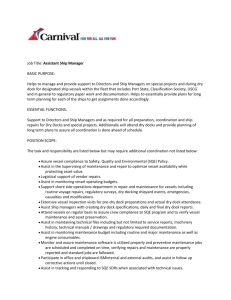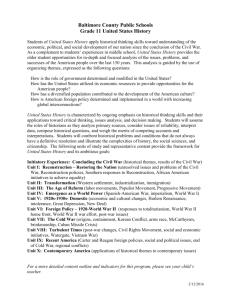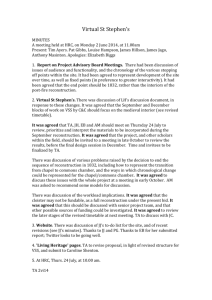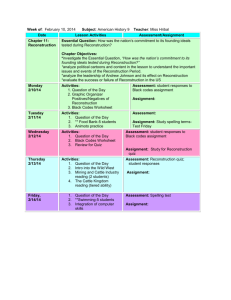HIST 6890
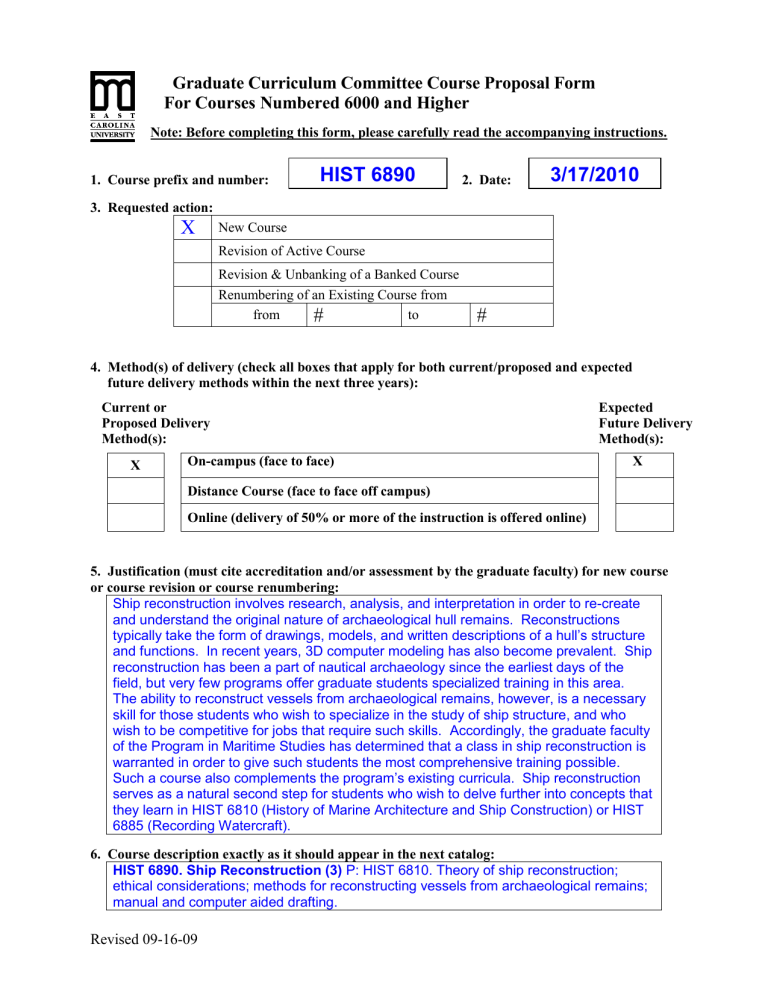
Graduate Curriculum Committee Course Proposal Form
For Courses Numbered 6000 and Higher
Note: Before completing this form, please carefully read the accompanying instructions.
1. Course prefix and number:
3/17/2010
3. Requested action:
X New Course
Revision of Active Course
Revision & Unbanking of a Banked Course
Renumbering of an Existing Course from
from # to #
4. Method(s) of delivery (check all boxes that apply for both current/proposed and expected
future delivery methods within the next three years):
Current or
Proposed Delivery
Method(s):
Expected
Future Delivery
Method(s):
X
On-campus (face to face) X
Distance Course (face to face off campus)
Online (delivery of 50% or more of the instruction is offered online)
5. Justification (must cite accreditation and/or assessment by the graduate faculty) for new course or course revision or course renumbering:
Ship reconstruction involves research, analysis, and interpretation in order to re-create and understand the original nature of archaeological hull remains. Reconstructions typically take the form of drawings, models, and written descriptions of a hull’s structure and functions. In recent years, 3D computer modeling has also become prevalent. Ship reconstruction has been a part of nautical archaeology since the earliest days of the field, but very few programs offer graduate students specialized training in this area.
The ability to reconstruct vessels from archaeological remains, however, is a necessary skill for those students who wish to specialize in the study of ship structure, and who wish to be competitive for jobs that require such skills. Accordingly, the graduate faculty of the Program in Maritime Studies has determined that a class in ship reconstruction is warranted in order to give such students the most comprehensive training possible.
Such a course also complements the program’s existing curricula. Ship reconstruction serves as a natural second step for students who wish to delve further into concepts that they learn in HIST 6810 (History of Marine Architecture and Ship Construction) or HIST
6885 (Recording Watercraft).
6. Course description exactly as it should appear in the next catalog:
HIST 6890. Ship Reconstruction (3) P: HIST 6810. Theory of ship reconstruction; ethical considerations; methods for reconstructing vessels from archaeological remains; manual and computer aided drafting.
Revised 09-16-09
7. If this is a course revision, briefly describe the requested change:
N/A
8. Graduate catalog page number from current (.pdf) graduate catalog:
9. Course credit:
Lecture Hours 3 Weekly OR Per Term Credit Hours
Lab
Studio
Practicum
Weekly OR Per Term Credit Hours
Weekly OR Per Term Credit Hours
Weekly OR Per Term Credit Hours
Internship Weekly OR Per Term Credit Hours
Other (e.g., independent study) Please explain.
Total Credit Hours
10. Anticipated annual student enrollment:
11. Affected degrees or academic programs:
8
Degree(s)/Program(s) Current Catalog Page
91
3
3
Changes in Degree Hours s.h. s.h. s.h. s.h. s.h. s.h.
MA in Maritime Studies 87-88
12. Overlapping or duplication with affected units or programs:
None
X Not applicable
Notification & response from affected units is attached
13. Council for Teacher Education (CTE) approval (for courses affecting teacher education):
X Not applicable
Applicable and CTE has given their approval.
14. Service-Learning Advisory Committee (SLAC) approval
X Not applicable
Applicable and SLAC has given their approval.
15.
Statements of support: a. Staff
X Current staff is adequate
Additional staff is needed (describe needs in the box below): b. Facilities
X Current facilities are adequate
Additional facilities are needed (describe needs in the box below):
Revised 09-16-09
c
.
Library
X Initial library resources are adequate
Initial resources are needed (in the box below, give a brief explanation and an estimate for the cost of acquisition of required initial resources): d. Unit computer resources
X Unit computer resources are adequate
Additional unit computer resources are needed (in the box below, give a brief explanation and an estimate for the cost of acquisition): e. ITCS resources
X ITCS resources are not needed
The following ITCS resources are needed (put a check beside each need):
Mainframe computer system
Statistical services
Network connections
Computer lab for students
Software
Approval from the Director of ITCS attached
16. Course information (see: Graduate Curriculum and Program Development Manual for instructions): a. Textbook(s) and/or readings: author(s), name, publication date, publisher, and city/state/country
Hocker, Frederick M., and Cheryl Ward, editors (2004). The Philosophy of
Shipbuilding: Conceptual Approaches to the Study of Wooden Ships . College
Station, TX: Texas A&M University Press.
Steffy, J. Richard (1994). Wooden Ship Building and the Interpretation of
Shipwrecks . College Station, TX: Texas A&M University Press. b. Course objectives for the course (student – centered, behavioral focus)
By the end of the course, students will be able to:
1. Explain the history, theory, and techniques of ship reconstruction;
2. Critique case studies of ship reconstruction in maritime archaeology;
3. Analyze the properties of woods used in shipbuilding;
4. Classify and describe the types of tools used in shipbuilding, and recognize archaeological signatures of these tools;
5. Analyze and explain the advantages and disadvantages of various reconstruction methods, including drawings, models, and
Revised 09-16-09
computer reconstructions;
6. Reconstruct a hull according to the following methodology:
1. Background research
2. Analysis of archaeological remains
3. Construction of a model
4. Manual drafting of lines, construction plans, and detailed drawings
5. Computer aided drafting of lines, construction plans, and detailed drawings
6. Writing a paper that describes the reconstruction and the evidence on which it is based c. Course topic outline
1. Introduction to ship reconstruction
2. Ethics: when and why to raise a hull
3. Categories of evidence for ship reconstructions: uses and abuses
4. History of ship reconstruction: case studies: a. The 7 th century Yassıada vessel b. The Serçe Limanı vessel c. The Bozburun ship d. Vasa
5. Properties of wood used in shipbuilding
6. Shipbuilding tools and their archaeological signatures
7. HABS/HAER standards for documenting and drawing vessels
8. How to research ships
9. Lines drawings
10. Construction plans
11. Detail drawings
12. Reconstructing sailing rigs
13. Computer aided drafting using Rhinoceros and MultiSurf
Revised 09-16-09
d. List of course assignments, weighting of each assignment, and grading/evaluation system for determining a grade
Course Requirements and Grading:
1. Participation (10%)
2. Semester Project (90%)
Details of Assignments:
Participation: The course will involve field trips (e.g., to the NC
Maritime Museum in Beaufort) as well as work at the drafting lab.
Students are expected to take part in all of these activities. Students are also expected to do the assigned readings for each class session and come to class prepared to discuss them.
Semester Project: Ninety percent of your final grade will depend on an individual ship reconstruction project. This will consist of a set of construction plans, a model, a computer reconstruction, and a paper.
Choice of vessel is completely up to you, within the following parameters:
It must be built of wood.
No dugouts, rafts, birchbark canoes, etc.
It must be at least 10 m long but no more than 50 m.
It may not be a specific vessel for which plans already exist, or a direct copy of such.
It must be a vessel type that actually existed.
You will find that some vessels are simply not practical for a semester project: 100-gun ships of the line, for example. Within the limits above, the possibilities are endless. The project is supposed to be fun, so use your imagination. If you can do a vessel that helps out with your thesis or personal research, all the better.
Like your choice of vessel, your reconstruction is completely up to you, as long as you can justify your decisions with archaeological, historical, and iconographic data.
Select your vessel early, as this project will take some time. You must turn in your topic selection and a preliminary bibliography by the end of
January.
Details for the 4 parts of this assignment are provided below:
Part 1: Lines & Construction Plans
The drawings must include at least the following:
Lines (half-breadth, sheer plan, and body plan)
Longitudinal construction plan
Deck & framing plan
Revised 09-16-09
Revised 09-16-09
Midships section
Optional drawings include:
Additional sections
Exterior profile
Mast & spar plan
Sail plan
All drawings must be correctly labeled (project name, drawing description, your name, scale, and date completed) and signed by you.
You will be graded on accuracy and neatness. You may ink your drawings if you like, but if you lack inking experience, concentrate on good pencil work instead.
Part 2: Model
The model will illustrate some significant feature of your vessel. For example, a Western river steamboat model might show the arrangement of paddle wheels, or a bomb ketch might depict the structure required to support the mortar.
Part 3: Computer Reconstruction
Like the model, the computer reconstruction will depict a significant feature of your vessel. You may, but are not required to, do the same feature that you built as a model. Computer reconstructions can be done using either Rhino or MultiSurf CAD programs.
Part 4: Paper
This will consist of a short (3,000 words or thereabouts) analysis of the vessel’s purpose, form, and construction, a table of principal dimension, and a scantling list. The text should not be merely a description of the vessel (that is the purpose of the drawings), but your analysis of why it was built the way it was and how it was suited (or not) to its intended purpose. Topics you might address include choice of materials and fastening methods, vessel size and cost, function, performance, and durability. You are free to add additional pertinent information, such as capacity, or type and weight of armament if your vessel is a warship.
GRADING SCALE
A: 93-100%
B:
C:
F:
86-92%
76-85%
0-75%




